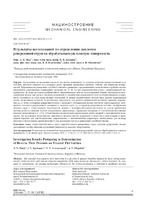| dc.contributor.author | Жук, А. Н. | ru |
| dc.contributor.author | Качанов, И. В. | ru |
| dc.contributor.author | Веременюк, В. В. | ru |
| dc.contributor.author | Филипчик, А. В. | ru |
| dc.coverage.spatial | Минск | ru |
| dc.date.accessioned | 2018-02-09T06:39:31Z | |
| dc.date.available | 2018-02-09T06:39:31Z | |
| dc.date.issued | 2018 | |
| dc.identifier.citation | Результаты исследований по определению давления реверсивной струи на обрабатываемую плоскую поверхность = Investigation Results Pertaining to Determination of Reverse Flow Pressure on Treated Flat Surface / А. Н. Жук [и др.] // Наука и техника. – 2018. – № 1. - С. 5-13. | ru |
| dc.identifier.uri | https://rep.bntu.by/handle/data/37504 | |
| dc.description.abstract | Проведенные исследования показали, что весьма экономично и с малыми затратами мощности можно подготовить листовой материал под лазерную резку, применяя реверсивно-струйную очистку для обработки поверхностей. Эффективность реверсивно-струйной очистки в сравнении с традиционными технологиями струйной очистки объясняется существенным повышением давления (на 25–50 %) при взаимодействии струи с обрабатываемой поверхностью. В статье на основе приближенного энергетического метода (метода верхней оценки) предлагается математическая модель для расчета давления разрушения от воздействия реверсивной струи на обрабатываемую поверхность, состоящую из слоя коррозионных отложений. В рамках разработанной модели была решена вариационная задача, позволившая получить теоретическую зависимость для расчета минимальной величины давления разрушения p/min в точке соударения реверсивной струи с преградой, учитывающая предел текучести деформируемого материала σ/s, плотность разрушаемого материала ρ, скорость струи υ/стр и параметр реверсивного течения – коэффициент обжатия струи λ. Сопоставление теоретических данных с экспериментальными (получены на основе применения датчика разности давления ЭДП-30 и пружинного динамометра с пределами измерения 25 и 80 МПа соответственно) показало расхождение в 4–15 %. Установленное незначительное расхождение между теорией и экспериментом показывает, что полученная теоретическая зависимость является вполне корректной и может быть использована в инженерной практике для прогнозирования энергосиловых и кинематических параметров, необходимых для подбора насосного оборудования, предназначенного для реализации процесса реверсивно-струйной очистки. | ru |
| dc.language.iso | ru | ru |
| dc.publisher | БНТУ | ru |
| dc.subject | Энергетический метод | ru |
| dc.subject | Метод верхней оценки | ru |
| dc.subject | Реверсивная струя | ru |
| dc.subject | Давление разрушения | ru |
| dc.subject | Датчик давления | ru |
| dc.subject | Пружинный динамометр | ru |
| dc.subject | Насосное оборудование | ru |
| dc.subject | Power method | en |
| dc.subject | Upper-bound method | en |
| dc.subject | Reverse jet | en |
| dc.subject | Fracture pressure | en |
| dc.subject | Pressure transducer | en |
| dc.subject | Spring dynamometer | en |
| dc.subject | Pump equipment | en |
| dc.title | Результаты исследований по определению давления реверсивной струи на обрабатываемую плоскую поверхность | ru |
| dc.title.alternative | Investigation Results Pertaining to Determination of Reverse Flow Pressure on Treated Flat Surface | en |
| dc.type | Article | ru |
| dc.identifier.doi | 10.21122/2227-1031-2018-17-1-5-13 | |
| local.description.annotation | The executed investigations have shown that it is possible to prepare sheet-like material for laser cutting economically viable and with small amount of power expenditure while using reverse jet cleaning for surface treatment. As compared to conventional jet cleaning technologies efficiency of the reverse jet cleaning is attributed to significant pressure increase (by 25–50 %) when the jet is interacting with the treated surface. The paper proposes a mathematical model on the basis of approximate energy method (upper-bound method) and the model is used for calculation of fracture pressure due to action of the reverse jet on the treated surface which consists of a corrosion deposit layer. A variational problem was solved within a framework of the developed model and the problem solution has made it possible to obtain a theoretical dependence for calculation of minimum fracture pressure value p/min in the point reverse jet impact with a barrier oretical dependence and it has taken into account yielding point of the deformed material σ/s, density of fractured material med material ρ, jet velocity υ/стр and parameter of reverse flowing – jet reduction ratio λ. Comparison theoretical data and experimental ones (experimental data have been obtained while using a differential pressure transducer ЭДП-30 and a spring dynamometer with measuring limits 25 and 80 MPa, respectively) has shown difference by 4–15 %. Determined insignificant difference between a theory and an experiment demonstrates that the obtained theoretical dependence is considered as a quite correct one and it can be used in engineering practice for prediction of power and kinematics parameters which are necessary for selection of the required pump equipment designed for realization of reverse-jet cleaning process. | en |

